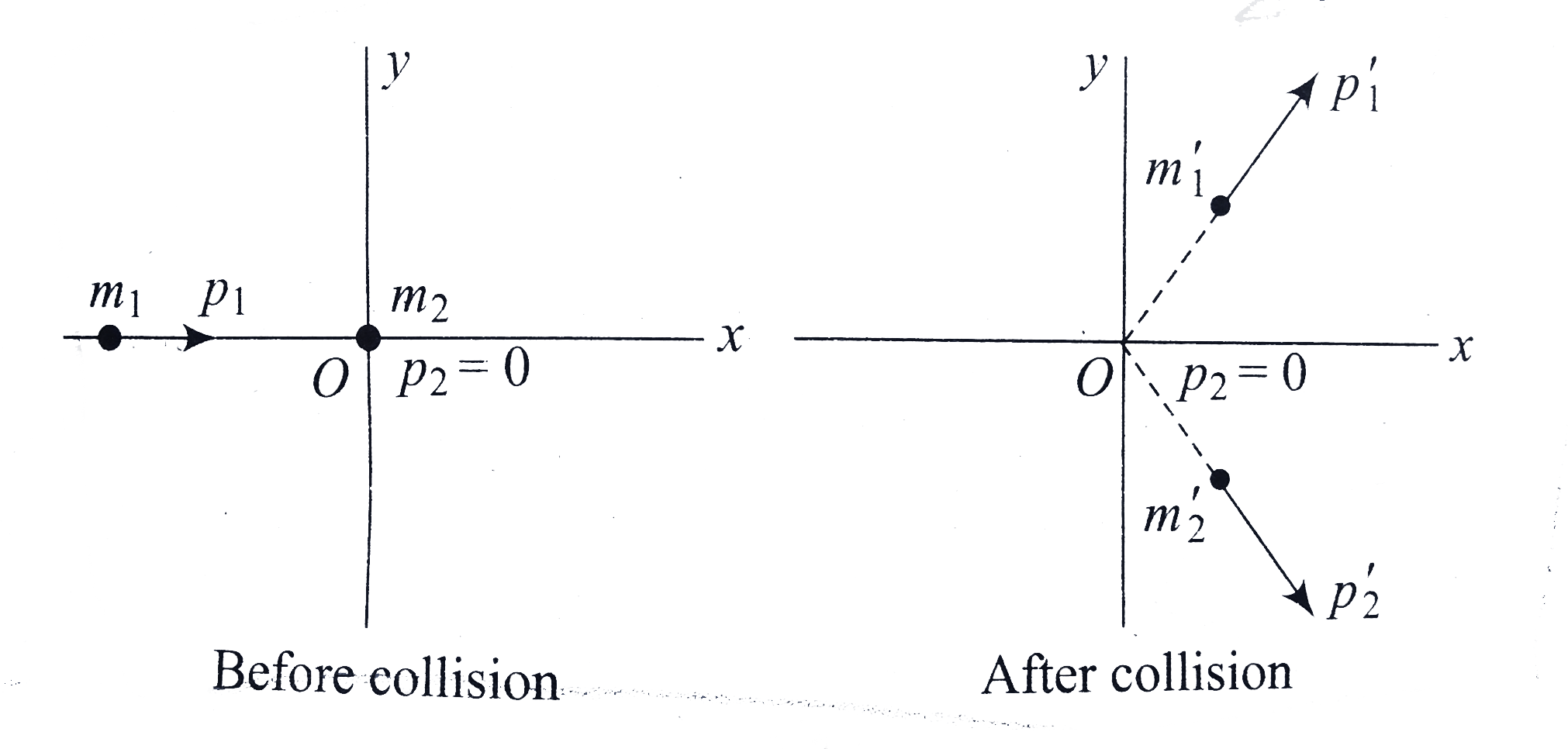A body of mass 1 kg moving in the x-direction, suddenly explodes into two fragments of mass 1/8 kg and 7/8 kg. An instant later, the smaller fragment is 0.14 m above the x-axis. The position of the heavier fragment is:
1/510 m above x-axis
1/ 50 m below x-axis
7/50 m below x-axis
7/50 m above x-axis
The correct Answer is:B
To solve the problem step by step, we will use the principle of conservation of momentum and the concept of the center of mass.
Step 1: Understand the initial conditions
Initially, we have a body of mass 1 kg moving in the x-direction. After the explosion, it splits into two fragments:
- Smaller fragment (m1) = 1/8 kg
- Heavier fragment (m2) = 7/8 kg
Step 2: Analyze the position of the smaller fragment
At a later instant, the smaller fragment (1/8 kg) is located 0.14 m above the x-axis. This means its y-coordinate (y1) is +0.14 m.
Step 3: Apply the conservation of momentum in the y-direction
Since the body was initially moving only in the x-direction, its initial momentum in the y-direction was zero. Therefore, the total momentum in the y-direction after the explosion must also be zero. This gives us the equation:
m1⋅y1+m2⋅y2=0
Step 4: Substitute the known values into the equation
Substituting the known values into the equation:
- m1 = 1/8 kg
- y1 = 0.14 m
- m2 = 7/8 kg
- y2 = ? (this is what we need to find)
The equation becomes:
18⋅0.14+78⋅y2=0
Step 5: Solve for y2
Rearranging the equation to solve for y2:
78⋅y2=−18⋅0.14
y2=−0.147
Calculating y2:
y2=−0.02m
Step 6: Interpret the result
The negative sign indicates that the heavier fragment (7/8 kg) is located 0.02 m below the x-axis.
Conclusion
The position of the heavier fragment is:
y2=−0.02m
Initially, we have a body of mass 1 kg moving in the x-direction. After the explosion, it splits into two fragments:
- Smaller fragment (m1) = 1/8 kg
- Heavier fragment (m2) = 7/8 kg
At a later instant, the smaller fragment (1/8 kg) is located 0.14 m above the x-axis. This means its y-coordinate (y1) is +0.14 m.
Since the body was initially moving only in the x-direction, its initial momentum in the y-direction was zero. Therefore, the total momentum in the y-direction after the explosion must also be zero. This gives us the equation:
m1⋅y1+m2⋅y2=0
Substituting the known values into the equation:
- m1 = 1/8 kg
- y1 = 0.14 m
- m2 = 7/8 kg
- y2 = ? (this is what we need to find)
18⋅0.14+78⋅y2=0
Rearranging the equation to solve for y2:
78⋅y2=−18⋅0.14
y2=−0.147
y2=−0.02m
The negative sign indicates that the heavier fragment (7/8 kg) is located 0.02 m below the x-axis.
The position of the heavier fragment is:
y2=−0.02m
Topper's Solved these Questions
- SYSTEM OF A PARTICLES & ROTATIONAL MOTIONBOOK - VMC MODULES ENGLISHCHAPTER - SYSTEM OF A PARTICLES & ROTATIONAL MOTIONEXERCISE - IN-CHAPTER EXERCISE B
10 Videos
- SYSTEM OF A PARTICLES & ROTATIONAL MOTIONBOOK - VMC MODULES ENGLISHCHAPTER - SYSTEM OF A PARTICLES & ROTATIONAL MOTIONEXERCISE - IN-CHAPTER EXERCISE C
10 Videos
- SYSTEM OF A PARTICLES & ROTATIONAL MOTIONBOOK - VMC MODULES ENGLISHCHAPTER - SYSTEM OF A PARTICLES & ROTATIONAL MOTIONEXERCISE - PRACTICE EXERCISE-7
5 Videos
- SIMPLE HARMONIC MOTION BOOK - VMC MODULES ENGLISHCHAPTER - SIMPLE HARMONIC MOTION EXERCISE - 7-previous year question
46 Videos
- SYSTEM OF PARTICLES AND ROTATIONAL MOTIONBOOK - VMC MODULES ENGLISHCHAPTER - SYSTEM OF PARTICLES AND ROTATIONAL MOTIONEXERCISE - IMPECCABLE
56 Videos
Similar Questions
An isolated particle of mass m is moving in horizontal planexy along the x-axis, at a certain height above the ground. It suddenly explodes into two fragment of masses m/4 and 3m/4. An instant later, the smaller fragment is at y=+15 cm. The larger fragment at this instant is at
View SolutionA stone of mass m1 moving at uniform speed v suddenly explodes into two fragments. If the fragment of mass m2 is at rest, the speed of the other fragment is
View SolutionA shell of mass 20kg at rest explodes into two fragments whose masses are in the ratio 2:3. The smaller fragment moves with a velocity of 6m/s. The kinetic energy of the larger fragment is
View SolutionA shell of mass 20kg at rest explodes into two fragments whose masses are in the ratio 2:3. The smaller fragment moves with a velocity of 6m/s. The kinetic energy of the larger fragment is
View SolutionA stationary body explodes into two fragments of masses m1 and m2. If momentum of one fragment is p, the energy of explosion is
View SolutionA stationary body explodes into two fragments of masses m1 and m2. If momentum of one fragment is p, the energy of explosion is
View SolutionAn asteroid orbiting around a planet in circular orbit suddenly explodes into two fragments in mass ratio 1:4 If immediately after the explosion, the smaller fragment starts obriting the planet in reverse direction in the same orbit, what will happen with the heavier fragment?
View SolutionConsider a body at rest in the L-Frame, which explodes into fragments of masses m1 and m2. Calculate energies of the fragments of the body.

View SolutionA shell is fired from a cannon with a speed of 100m/s at an angle 30∘with the vertical (y-direction). At the highest point of its trajectory, the shell explodes into two fragments of masses in the ratio 1:2. The lighter fragment moves vertically upwards with an initial speed of 200m/s. What is the speed of the heavier fragment at the time of explosion?
View SolutionA shell of mass 2kg moving at a rate of 4m/s suddenly explodes into two equal fragments. The fragments go in directions inclined with the original line of motion with equal velocities, If the explosion imparts 48J of translational kinetic energy to the fragments, find the velocity and direction of each fragment.
View Solution
